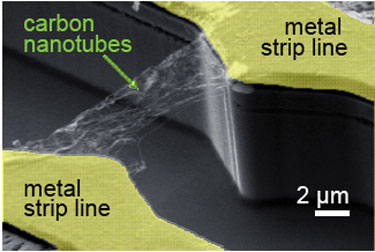| Jan 19, 2011 |
Speed detection of electrons in nanoscale photodetectors
|
|
(Nanowerk News) In solar cells and photodetectors, an optical radiation excites electrons to higher energy states, thereby a photocurrent begins to flow. Scientists led by Professor Alexander
Holleitner, physicist at the Technische Universität Muenchen (TUM), have found a way to directly measure the time during which photo-excited electrons flow in nanoscale photodetectors ("Time-Resolved Picosecond Photocurrents in Contacted Carbon Nanotubes").
|
 |
| A carbon nanotube network is contacted by two metal strip lines.
|
|
The scientists could resolve the photocurrents on a picosecond time-scale which is about
one-hundred times faster than is possible by conventional methods (a picosecond is one part
in a billion of a millisecond). Most importantly, that is the time-scale at which electrons propagate
in nanoscale photodetectors.
|
|
The reported method employs stripline circuits with a THz-band width, which are read-out by an ultrafast pump-probe laser spectroscopy. The researchers demonstrated the technique on carbon nanotubes with a diameter of only a nanometer (one millionth of a millimeter), which were electronically contacted by metal strip lines.
|
|
The results allowed the researchers to directly measure the speed of photo-excited electrons which is about 375 times slower than the speed of light.
|
|
The insights and analytic opportunities made possible by the presented technique are relevant
to a whole range of applications. These include, most notably, the further development
of optoelectronic components such as nanoscale photodetectors, photoswitches, and solar
cells.
|
|
The studies were funded by the Cluster of Excellence Nanosystems Initiative Munich (NIM)
of the Deutsche Forschungsgemeinschaft, the Center for NanoScience (CeNS), and LMUexcellent.
|

